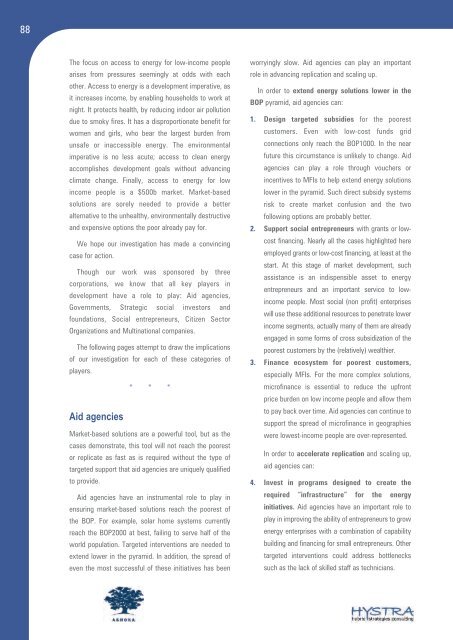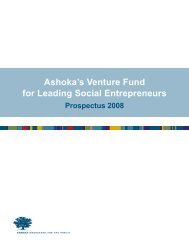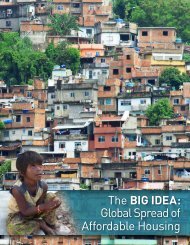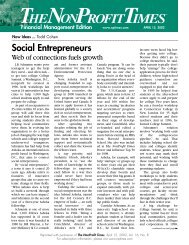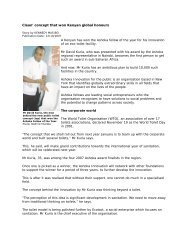Access to Energy for the Base of the - Ashoka
Access to Energy for the Base of the - Ashoka
Access to Energy for the Base of the - Ashoka
Create successful ePaper yourself
Turn your PDF publications into a flip-book with our unique Google optimized e-Paper software.
88<br />
The focus on access <strong>to</strong> energy <strong>for</strong> low-income people<br />
arises from pressures seemingly at odds with each<br />
o<strong>the</strong>r. <strong>Access</strong> <strong>to</strong> energy is a development imperative, as<br />
it increases income, by enabling households <strong>to</strong> work at<br />
night. It protects health, by reducing indoor air pollution<br />
due <strong>to</strong> smoky fires. It has a disproportionate benefit <strong>for</strong><br />
women and girls, who bear <strong>the</strong> largest burden from<br />
unsafe or inaccessible energy. The environmental<br />
imperative is no less acute; access <strong>to</strong> clean energy<br />
accomplishes development goals without advancing<br />
climate change. Finally, access <strong>to</strong> energy <strong>for</strong> low<br />
income people is a $500b market. Market-based<br />
solutions are sorely needed <strong>to</strong> provide a better<br />
alternative <strong>to</strong> <strong>the</strong> unhealthy, environmentally destructive<br />
and expensive options <strong>the</strong> poor already pay <strong>for</strong>.<br />
We hope our investigation has made a convincing<br />
case <strong>for</strong> action.<br />
Though our work was sponsored by three<br />
corporations, we know that all key players in<br />
development have a role <strong>to</strong> play: Aid agencies,<br />
Governments, Strategic social inves<strong>to</strong>rs and<br />
foundations, Social entrepreneurs, Citizen Sec<strong>to</strong>r<br />
Organizations and Multinational companies.<br />
The following pages attempt <strong>to</strong> draw <strong>the</strong> implications<br />
<strong>of</strong> our investigation <strong>for</strong> each <strong>of</strong> <strong>the</strong>se categories <strong>of</strong><br />
players.<br />
Aid agencies<br />
* * *<br />
Market-based solutions are a powerful <strong>to</strong>ol, but as <strong>the</strong><br />
cases demonstrate, this <strong>to</strong>ol will not reach <strong>the</strong> poorest<br />
or replicate as fast as is required without <strong>the</strong> type <strong>of</strong><br />
targeted support that aid agencies are uniquely qualified<br />
<strong>to</strong> provide.<br />
Aid agencies have an instrumental role <strong>to</strong> play in<br />
ensuring market-based solutions reach <strong>the</strong> poorest <strong>of</strong><br />
<strong>the</strong> BOP. For example, solar home systems currently<br />
reach <strong>the</strong> BOP2000 at best, failing <strong>to</strong> serve half <strong>of</strong> <strong>the</strong><br />
world population. Targeted interventions are needed <strong>to</strong><br />
extend lower in <strong>the</strong> pyramid. In addition, <strong>the</strong> spread <strong>of</strong><br />
even <strong>the</strong> most successful <strong>of</strong> <strong>the</strong>se initiatives has been<br />
worryingly slow. Aid agencies can play an important<br />
role in advancing replication and scaling up.<br />
In order <strong>to</strong> extend energy solutions lower in <strong>the</strong><br />
BOP pyramid, aid agencies can:<br />
1. Design targeted subsidies <strong>for</strong> <strong>the</strong> poorest<br />
2.<br />
cus<strong>to</strong>mers. Even with low-cost funds grid<br />
connections only reach <strong>the</strong> BOP1000. In <strong>the</strong> near<br />
future this circumstance is unlikely <strong>to</strong> change. Aid<br />
agencies can play a role through vouchers or<br />
incentives <strong>to</strong> MFIs <strong>to</strong> help extend energy solutions<br />
lower in <strong>the</strong> pyramid. Such direct subsidy systems<br />
risk <strong>to</strong> create market confusion and <strong>the</strong> two<br />
following options are probably better.<br />
Support social entrepreneurs with grants or lowcost<br />
financing. Nearly all <strong>the</strong> cases highlighted here<br />
employed grants or low-cost financing, at least at <strong>the</strong><br />
start. At this stage <strong>of</strong> market development, such<br />
assistance is an indispensible asset <strong>to</strong> energy<br />
entrepreneurs and an important service <strong>to</strong> lowincome<br />
people. Most social (non pr<strong>of</strong>it) enterprises<br />
will use <strong>the</strong>se additional resources <strong>to</strong> penetrate lower<br />
income segments, actually many <strong>of</strong> <strong>the</strong>m are already<br />
engaged in some <strong>for</strong>ms <strong>of</strong> cross subsidization <strong>of</strong> <strong>the</strong><br />
poorest cus<strong>to</strong>mers by <strong>the</strong> (relatively) wealthier.<br />
3. Finance ecosystem <strong>for</strong> poorest cus<strong>to</strong>mers,<br />
especially MFIs. For <strong>the</strong> more complex solutions,<br />
micr<strong>of</strong>inance is essential <strong>to</strong> reduce <strong>the</strong> upfront<br />
price burden on low income people and allow <strong>the</strong>m<br />
<strong>to</strong> pay back over time. Aid agencies can continue <strong>to</strong><br />
support <strong>the</strong> spread <strong>of</strong> micr<strong>of</strong>inance in geographies<br />
were lowest-income people are over-represented.<br />
In order <strong>to</strong> accelerate replication and scaling up,<br />
aid agencies can:<br />
4. Invest in programs designed <strong>to</strong> create <strong>the</strong><br />
required “infrastructure” <strong>for</strong> <strong>the</strong> energy<br />
initiatives. Aid agencies have an important role <strong>to</strong><br />
play in improving <strong>the</strong> ability <strong>of</strong> entrepreneurs <strong>to</strong> grow<br />
energy enterprises with a combination <strong>of</strong> capability<br />
building and financing <strong>for</strong> small entrepreneurs. O<strong>the</strong>r<br />
targeted interventions could address bottlenecks<br />
such as <strong>the</strong> lack <strong>of</strong> skilled staff as technicians.


